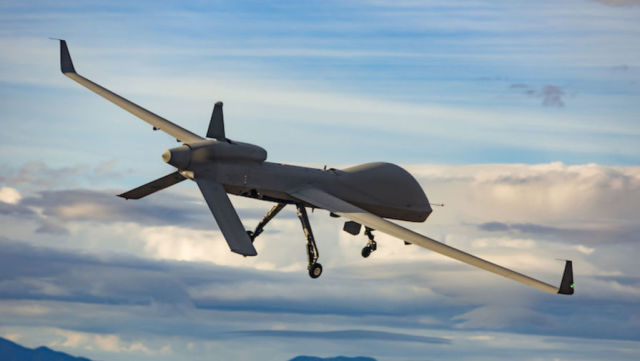What threat does the modernization of the American MQ-1C Grey Eagle pose to Russia?
The US army requires that the MQ-1C Grey Eagle drones, designed to participate in multi-domain operations, have a synthetic aperture radar, indicators of moving targets, and radio and radio intelligence tools. Having received such opportunities, as the authors of the idea believe, American UAVS will be able to" look " at the territory of US opponents, including Russia.
The ground forces of the US armed forces need the help of the military-industrial complex to modernize unmanned aerial vehicles of the MQ-1C Grey Eagle type, writes Defense News. In particular, the military needs systems that can conduct joint operations in all areas of the armed struggle against such opponents as China and Russia.
Specialists in the field of radar, optics and sensors set the task for the American defense industry to analyze existing and promising models of weapons and military equipment. They must ensure effective aerial reconnaissance and surveillance when deployed on the MQ-1C Gray Eagle platform. It is emphasized that the equipment must meet the requirements for conducting multi-domain operations.
This approach assumes that target detection should be performed without the use of traditional visual surveillance equipment, including electron-optical and infrared.
The above methods, which are used today, are mainly aimed at fighting irregular formations, and therefore they cannot be used in combat operations with equal opponents (or close to them).
The us military requires that Grey Eagle unmanned aerial vehicles can survive in an integrated air defense system. In fact, this means that the drone will fly in a circle (or eights) at a distance of about 80 km from the starting positions of the SAM, while
In addition, the Gray Eagle UAV must have intelligence equipment that can detect threats coming from a potential enemy's SAMS, determine their location and transmit information about this to other sensor systems that can recognize targets and coordinate firing at them from long ranges.
The us army is currently conducting research on the characteristics of advanced equipment for the Grey Eagle UAV. A demonstration of the capabilities of an unmanned aerial vehicle under the concept of multi-domain operations can potentially take place in the 2022 fiscal year. It is assumed that by this time the most efficient and cost-optimal payloads for this type of UAV WILL be found based on the availability of appropriate technologies and production costs.
The request for a more advanced payload for the Grey Eagle comes at a time when the Us army is trying to develop a complex architecture of helicopters and unmanned aircraft systems that will be part of integrated chains of destruction of enemy objects. It is also planned to use space and ground resources, supported by developed computer networks.
The US army has already experimented with destruction chains to include air assets in the so-called Project Convergence at the Yuma test site (Arizona) during this summer. Previously, " Gazeta.Ru " wrote about these exercises.
Then, during the exercise, experimental unmanned aerial vehicles, "superpuns", ground robots and space vehicles of the orbital group were combined into a single unit for large-scale verification of future plans for conducting combat operations.
Such efforts combine future weapons and capabilities envisioned for the battlefield of the 2030s with near-equal opponents such as Russia and China. They include the use of a developed combat management system based on machine learning and artificial intelligence.
In this regard, the Gray Eagle UAV is a prototype of the future attack reconnaissance aircraft (Fara).
During the first phase of the exercise at the Yuma range - "Penetration" - the detection of positions of anti-aircraft missile systems and complexes by spacecraft in low earth orbits was practiced. This information was transmitted to a ground processing station located more than a thousand miles from Yuma. The station operators sent the necessary data about the target to the Yuma range, where the combat crews processed the received information and sent it directly to the firing facilities.
This is the first way to destroy the enemy's air defense systems, including Russian "Shells" and other weapons. During the exercise in Arizona, it was possible to extend the range of use of Gray Eagle UAV weapons to 62 km.
In addition, the UAV used miniature planning corrected aircraft bombs of the GBU-69/B type manufactured by Dynetics. The length of the ammunition is 1.06 m, the diameter is 11.4 cm. The aerial bomb is equipped with a folding wing with a span of 71 cm. When dropped from a UAV, the bomb can plan for a distance of up to 37 km. GBU-69 / B with a mass of only 27 kg contains 16 kg of explosive.
Looking to the future, the us Army uses an open architecture that is flexible enough that any payloads and capabilities can be replaced with Grey Eagles without having to rely on the original equipment manufacturer for this purpose.
This device can be in the air for 30 hours, and given its flight altitude-more than eight thousand meters-the UAV reconnaissance means can cover significant border areas of Russia, "the Newspaper said.Ru " former Deputy chief of the Main operational Department of the General staff of the Russian armed forces, Lieutenant General Valery Zaparenko.
According to the military commander, with the help of these UAVS, the enemy can reveal the features of the control system of the Russian armed forces, the grouping of troops (forces) in strategic directions, the nature and direction of operational and combat training. This can only be countered by a wide variety of operational and strategic camouflage measures, General Zaparenko believes.
Mikhail Khodarenok

